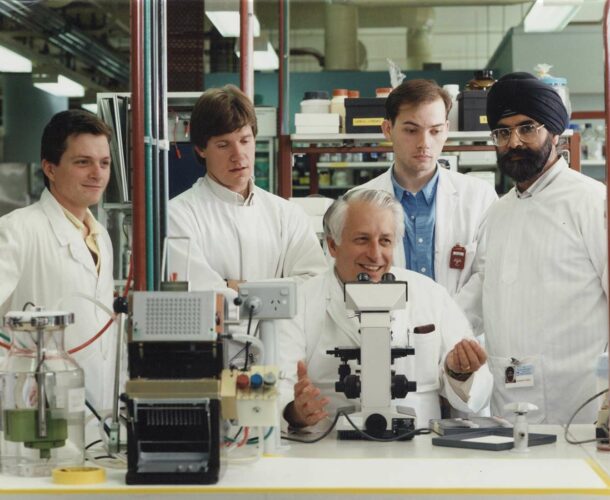“One of the most fascinating of immunological phenomena is that of memory.”1
So said Sir Gustav Nossal of the body’s ability to recognise, recall and resolve to eliminate its enemies.
In 1997 Nossal, PhD student Ken Smith and postdoc David Tarlinton make a crucial discovery about how B cell memory develops and is stored.
Immune memory
Immune memory is how vaccines provide us with long-lasting protection against disease. It also develops after we get an infection, such as chicken pox or the flu.
Whether we catch a virus, are infected with bacteria, or injected with a vaccine, the rare B cells that have the capacity to make antibodies that protect against that virus, bacteria or vaccine, are ‘activated’. These B cells have the in-built ability to make antibodies that fight disease. Each B cell can make one type of antibody.
But the best protection is to make the B cells with a proven ability to defend us from the infection live as long as we do, protecting us if or when we come into contact with the infection again. These lifelong immune cells are called plasma cells, and they supply the body with antibodies; hundreds to thousands of antibodies secreted into the blood, per cell, per second.
Training centres
The mystery of memory B cell formation began in the 1960s with Nossal and Gordon Ada’s discovery of follicular dendritic cells (FDCs). These cells trap foreign proteins to stimulate antibody production and drive immune memory.
In 1967, while at the institute on sabbatical leave, John Tew and Tom Mandel show that antigen can remain ‘stuck’ to FDCs, and retains its “full stimulatory power” for many months.
“It became tempting to postulate that while B cells were in the germinal centre they revisited the antigen depot repeatedly,” Nossal says.
“Perhaps on each occasion the only B cells which divided were those bearing mutations that raised antibody affinity?”
The pathway towards proving this was long and torturous.1
Bone marrow home
In 1997 PhD student Ken Smith, David Tarlinton and Nossal crack the case.
They show that the selection process for memory B cells begins in specialised ‘training’ camps inside lymph nodes – the germinal centres – and starts during the early stages of infection.
Out of this “cauldron” of developing cells, memory B cells are chosen based on their ability to make superior antibodies that are the most effective at fighting the infection. They are then promptly sent to live in the bone marrow, where they spend the rest of their lives – and yours – pumping out antibodies in response to new encounters with old enemies.
Or as Nossal explains: As well as producing memory B cells, the germinal centre also produces a special population of antibody-forming B [plasma] cells. These are B cells with raised affinity which are quickly exported from the germinal centre and which migrate to the bone marrow where they live for many months making their important contribution to immunological memory.”1
Nossal says this was the end of his 39 year-and-four-month love affair with immunological memory and germinal centres.
“The intervening years have been full and satisfying, but I will confess to a recurring dream. “I am back in the laboratory doing something clever and always devilishly difficult technically. The dream is tinged with self-indulgent sadness.”1
Yet it is also the beginning of Tarlinton’s fascination with B cells and memory, which will later turn immune memory ‘dogma’ on its head.






